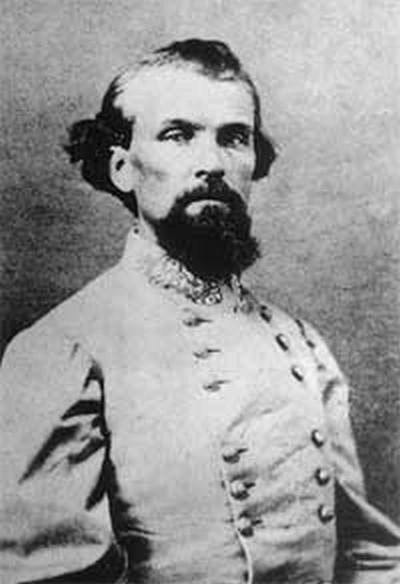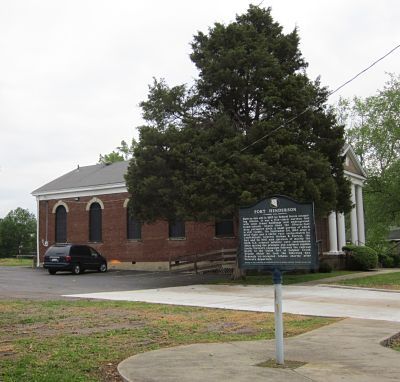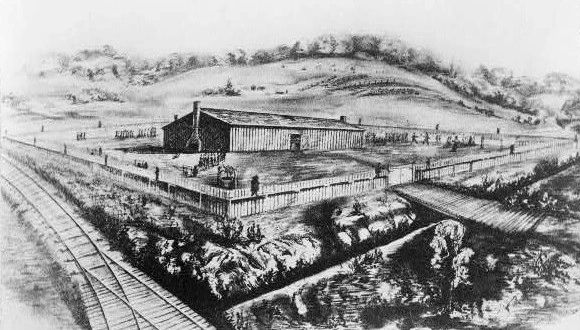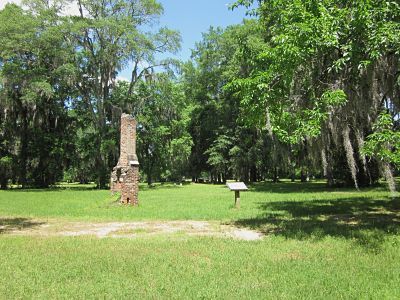Elijah Wallick – 102nd Ohio Infantry, Co. G
Rank: Private, promoted to Corporal
Place of enlistment:
Mustered into Federal service:
Service time: 2 Years, 9 months, 11 days
Born: April, 1831 –
Age at enlistment: 31
Height: 5’8” light hair, brown eyes
Civilian occupation: Farmer
Family Lineage
Elijah, son of Andrew, son of “
Elijah Wallick was a grandson of “
 Fort
Fort
At first glance it seems unfortunate that Elijah’s prison experiences had so broken his health that he was unable of celebrate with his comrades their release from captivity and the end of the war. However, the fact that he was so ill and needed to be hospitalized may have helped save his life. Had he been well enough to stay with his captured brethren he most likely would have been on board the ill-fated steamboat, Sultana. This vessel’s horrific demise is still considered the greatest maritime disaster in all
Elijah Escapes the Sultana Disaster!
At the end of the war steamboat captains received from the U.S. Government five dollars per enlisted man and ten dollars per officer to transport them north and on to home. However, some of the captains offered army officers a kick-back of $1. 15 for every soldier put on their boat, thus resulting in many boats stuffed way beyond their capacity with passengers. The Sultana was just such a vessel as it began its voyage

This photograph of the Sultana, which shows her decks overcrowded with passengers, was taken less than 24 hours before she exploded on the Mississippi River. Elijah would have been loaded on to this boat had he not been so seriously ill.
Those not killed by the explosion or trapped inside the burning boat jumped into the waters in an attempt to reach the shore. The
Had Elijah not been so seriously ill upon his release form prison he very well could have been another casualty in the Sultana tragedy. Had he been on the Sultana in his weakened state he most assuredly would not have survived the icy water of the
After Elijah’s extended stays in various army hospitals did eventually return home to
1862
AUG 9 Elijah and cousin David H. Wallick go into
SEP 6-22 Elijah is mustered into Federal service on September 6th in
SEP 22- Oct 6 The 102nd Regiment is moved to Louisville, KY, to bolster the defenses of that city in response to Confederate General Braxton Bragg’s move towards the Ohio River.
The 102nd Regiment is moved to Louisville, KY, to bolster the defenses of that city in response to Confederate General Braxton Bragg’s move towards the Ohio River.OCT 5-6 The men of the 102nd are assigned guard duty of the brigade wagon trains while pursuing General Bragg.
OCT 9 Battle of Perryville The 102nd is held in reserve and sees no action but they are close enough to hear the sounds of battle.
OCT 10 – DEC 30 After the Battle of Perryville, Elijah and his regiment move to Bowling Green, KY, where they are given the responsibility of security on the rail line from Bowling Green to Nashville, TN. On December 19th they are moved to
1863
JAN – SEP Elijah spends almost ten months in the vicinity of Clarksville, TN, building bridges, forwarding supplies and providing a secure base of operations for the Union Army.
JUL – AUG Elijah is detailed as an honor guard.
SEP 26 – 30 The 102nd is called on to help repel a Confederate cavalry raid by General Wheeler.
OCT – DEC Elijah and his regiment are moved to
1864
JAN – APR The 102nd remains in
APR 26 – JUN 6 Elijah’s primary responsibility is to help guard the
JUN – AUG The 102nd is part of the defensive line along the
SEP 1-15 The regiment has duty protecting the Tennessee Railroad from
SEP 23-24 Elijah is captured and becomes a prisoner-of-war. Elijah, with a detachment of soldiers from the 102nd Ohio, is sent to help relieve
“About the 20th of September the Confederate cavalry, under General Nathan Bedford Forrest, crossed the Tennessee River near Waterloo, AL, and appeared in front of Athens, Alabama. Considerable skirmishing took place and the garrison, occupied by the 106th, 110th, and 111th Colored Troops and commanded by Colonel Campbell, withdrew into the fort. By night-fall the town was completely invested and the quartermaster and commissary buildings were destroyed by the Confederates. On the morning of the 24th the Confederates opened fire on the fort with a 12-pounder battery, firing from two different directions, north and west, which was answered by the artillery from the garrison. Later two flags of truce were received demanding a surrender, which was declined by Colonel Campbell. When he was requested to grant Major-General Forrest a personal interview, he complied to meet with the general. At this interview Colonel Campbell allowed himself to become convinced by the Confederate commander that it was useless to contend against the larger superior forces of the enemy (This was untrue. General Forrest had his troops simply march in a circle to give the impression that he commanded a much larger force. He used this rue a number of times during the war. William Wallick was captured when his commanding officer was similarly deceived). The garrison at the time had overwhelming numbers to General Forrest’s Cavalry. Thirty minutes after the evacuation for surrender of the fort, re-enforcements consisting of the 102nd
The historical marker for Fort Henderson is located next to Trinity Congregational Church in Athens, Alabama. The structure was a five pointed fortress that covered many acres of the surrounding neighborhood.

Historical Marker Inscription

Elijah is captured and will spend the next six months in a warehouse that the Confederacy has converted into a Federal Prison.
OCT – DEC Elijah is held a prisoner-of-war in Cahaba, AL.
The town of
Castle Morgan or Cahaba Federal Prison Camp
At one point this facility held over 5,000 prisoners.

1865
JAN Elijah is still being held captive in Cahaba Federal Prison. Conditions are harsh, as are all Civil War prison camps.
FEB Elijah is admitted to the prison hospital with typhoid fever. He will suffer from a variety of diseases while a POW.
MAR 1 Severe flooding of the
This is the site of Castle Morgan, the converted warehouse and alternate name for Cahaba Federal Prison. It is located in the Cahaba Archeological Park, a few miles south of Selma, Alabama. Here Elijah and many other Federal soldiers suffered incarceration and many privations for the last six months of the war.

MAR 16 About this time the first group of soldiers from
MAR 30 Elijah is admitted to
APR 1 Elijah is sent to the army’s
APR 27- 2:00AM The Sultana explodes in a fireball of flame seven miles north of Memphis with over 1,700 passengers killed and hundreds of others burned and injured while attempting to reach the shoreline. A great many drown due to their weakened state as prisoners-of war and the frigid temperatures of the

A fate Elijah was fortunate to have missed.
Many friends and comrades perished that night.
MAY 25 Elijah is transferred from
JUN 1 Elijah is sent to
JUN 19 The 102nd Ohio Volunteer Regiment is mustered out of Federal service in
Comrades-in-Arms
Cousins
David H 102nd OH (same regiment & company)
Daniel 20th OH
David 139th OH
Henry 67th OH
Michael 27th IN

Elijah Wallick- Ladora, Iowa
His inscription reads:
E. Wallick
1831-1922
Co. G 102nd Reg Ohio Vol
Song- Lorena
Return to Top
Return to Wallick Family Website
